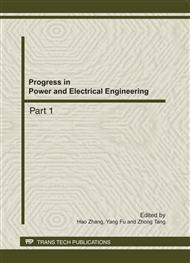p.1027
p.1031
p.1035
p.1041
p.1047
p.1051
p.1058
p.1064
p.1068
Spinning Reserve Optimization Model Based on Bi-Level Programming
Abstract:
How to determine spinning reserve reasonably in electricity market is one of the key questions which guarantee the security and reliability of power systems. For this issue, based on bi-level programming theory, an optimal model of spinning reserve is established in this paper. In this model the generation cost minimization and the reserve cost minimization are the upper level and lower level optimization object separately, and the network and “N-1”security constraints of the power system are also considered. The determination of reserve capacity and the reliability level are related, and the reserve rate of each unit is determined. And an IEEE-14 nodes test system case is used to demonstrate the feasibility and rationality of this proposed model.
Info:
Periodical:
Pages:
1047-1050
Citation:
Online since:
October 2011
Authors:
Keywords:
Price:
Сopyright:
© 2012 Trans Tech Publications Ltd. All Rights Reserved
Share:
Citation:


